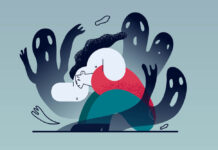A new article, just published online in the journal Emotional and Behavioural Difficulties, presents research suggesting that the diagnosis of ADHD is philosophically inadequate, fails to explain the complexity of children’s experiences, and may actually increase the distress experienced by children in the long run.
“ADHD, however adequate it may seem, is founded on inadequate knowledge,” the researchers write, “and the legitimacy of the individual diagnosis should, therefore, be questioned on the grounds that on a long term scale it is passivizing and stigmatizing rather than liberating.”

The researchers, Mattias Nilsson Sjöberg and Johan Dahlbeck, note that “Despite enormous amounts of medical research on ADHD it remains a fact that ‘[n]o biological marker is diagnostic for ADHD’. Accordingly, it is somewhat paradoxical that the same diagnostic manual defines ADHD as a neurodevelopmental disorder.”
However, they argue that “Diagnosis—however inadequate—may offer a kind of defense against mental distress (pain/sadness).” From this standpoint, they suggest that the most important question pertaining to ADHD is “Whose pain is primarily addressed?”
The evidence, according to the researchers, is that it is the distress of others—teachers and parents—that is being soothed via the diagnosis, rather than the distress of children themselves.
To make their point, the researchers cite a statement concerning ‘ADHD’ by the Swedish National Board of Health and Welfare:
“Parents who experience that their children are difficult to manage, without understanding why, are relieved when given a diagnosis and information about what it means. The diagnosis provides a name for the difficulties of the child and makes it easier for parents to acquire knowledge and to come in contact with others with similar experiences.”
Sjöberg and Dahlbeck summarize this: Children are considered to have the disorder if others (primarily teachers and parents) complain that the child does not focus attentively enough, sit still enough, or even play quietly enough. According to this guideline, diagnosis is effective because it provides an explanation, to others, regarding why the child does not meet the demands of the parent. For instance, if a child is playing loudly and running around, perhaps even at times the parent considers inappropriate, this can now be explained as a “disorder.”
Thus, as Sjöberg and Dahlbeck explain, the diagnosis of ADHD does not help the child so much as it provides an explanation to those who find the child’s behavior intolerable. Indeed, the authors state that “The labeling tends to target and benefit parents and other people in the child’s immediate environment rather than the child.”
The researchers cite studies that demonstrate the ways diagnosis helps parents and teachers make sense of the child’s behavior, while children themselves tend to try to distance themselves from the diagnosis. According to research on children’s experiences of ADHD diagnosis, they tend to feel that the diagnosis does not adequately explain or label their experience. Additionally, each individual child with the ADHD diagnosis may have a very different way of interacting with the world and may exhibit different symptoms. In this way, the diagnosis is inadequate for explaining the difficulties children experience.
Research has shown that the diagnosis of ADHD is most commonly given to the youngest children in the classroom. Despite the fact that these children are at a developmentally different stage, they are pathologized as having a mental illness. Children given the diagnosis are often given a diagnosis and medicated although they might be more energetic or simply younger than others.
It is also important to note that outcome research shows that stimulant medications do not result in better long-term outcomes for children. In some cases, medicated children had worse outcomes and far more adverse effects than children who did not receive treatment.
In terms of stigmatization and disempowerment, the psychiatric argument holds that biomedical explanations reduce blame by indicating that the child is not responsible for their behavior if they have the “disorder.” However, research has found that these explanations actually increase stigma and self-blame because they localize the problem within a damaged brain—essentially telling children that they are fundamentally broken individuals.
The diagnosis of ADHD has been increasingly criticized for many years. This year, in particular, has included calls for the retraction of misleading research falsely purporting to show a biological cause. Indeed, Keith Conners, the very researcher who performed the initial research into ADHD medications was a leader at criticizing the diagnosis. In addition, Allen Frances, who played a role in codifying ADHD as a mental health illness, has also been a powerful voice critiquing the diagnosis, especially the rampant overdiagnosis and overmedication of children that has accompanied it. Researchers have even argued that the diagnosis does not meet the DSM’s own criteria for a “disorder.”
The current researchers assert that rather than reducing the distress of children, the ADHD diagnosis soothes parents and teachers, but leaves children stigmatized and disempowered.
****
Sjöberg, M. N., & Dahlbeck, J. (2017). The inadequacy of ADHD: a philosophical contribution. Emotional and Behavioural Difficulties, doi: 10.1080/13632752.2017.1361709 (Link)















Thanks again Pete. This article is ‘spot on’…..
Let’s try it again in the simplest of terms. ADHD behavior is not a BAD thing, it is a GOOD thing. The Child or Young Adult receives a benefit from their BAD behavior. The benefit is an increase in the neurotransmitter DOPAMINE(DA) in the sensory area of the brain. The hallmark of ADHD is the ‘lower than normal’ level of DA in the brain, especially the SENSORY AREA and the PRE-FRONTAL CORTEX AREA. The Child or Young Adult, is SELF-MEDICATING with BAD BEHAVIOR. The people who suffer from ADHD are the Parents, Teachers, Health Care Providers and Peers, who do not have the PROBLEM. ADHD is not a Disease or Disorder, but a very ORDERED RESPONSE from the Autonomic Nervous System to maintain (DA) Homeostasis in the brain. Stimulants only take the place of BAD BEHAVIOR during the efficacy of the medication. Kids and Young Adults presenting ADHD Behavior are perfectly NORMAL in every respect. ADHD is just as NORMAL as, Shivering when you are cold or sweating when you are hot. The problem for us all is adapting to a ever changing and much more stimulating environment.
Hypothesis posted on Pete’s last article.
Chet
Report comment
Can you please tell me what the `normal’ levels of dopamine (or any other of the 100 or more neurotransmitters) in the brain are, and how this is measured? Because unless we have some kind of agreement on what is `normal’ we cannot know what is `abnormal’, can we?
And do we know how to relate any brain activity in the short term to behaviour in the long term?
And, are responses by the autonomic nervous system, presumably measured during fMRI procedures, a cause or a result of emotion, behaviour etc? (been a little problem with fMRI data interpretation lately)
And, since the DSM descriptions of ADHD, and nearly everything else, is so vague, and represents variations of normal behaviour making it a totally judgement call, is what is called ADHD anything at all?
I think not –
Unfortunately most mental `illness’ or emotional overwhelm is social in nature, but this is particularly true with ADHD – and the cynical drive to ever more riches by the PPA (Psychiatry/Pharmaceutical Alliance) will, or already has, destroyed an entire generation.
Report comment
deeo42,
The Homovanillic Acid 24 Hour Urine test (HVA) is the most accurate when determining a normal level of Dopamine. A qiick blood test for HVA can be done, but it is less accurate due to minuscule quantification’s involved. Age is also a factor. A sample reference for DA would be: 2-4 years < 25.0 mg/g Creatinine in a 24 hr collect. Dopamine Normal level charts can be found on the Mayo Clinic Site.
This test is used often to check Children for neuroblastoma as these tumors secrete a catecholamine. Dopamine is a catecholamine and so are its metabolites. You are absolutely correct; without knowing what is normal, a judgement of abnormal would be impossible. By the same token, if you don’t know the cause of ADHD behavior, you cannot know the proper diagnosis or cure for the problem. Ask any ADHD expert what the CAUSE is, and they will have to tell you they do not know.
The Mind uses the emotions of fear, stress and anxiety, to generate additional DA. this all takes place in the Limbic System (Old Brain) and is a unconscious process. fMRI,s would probably show the presence of DA in the brain, but not a quantification.
Our mind, in association with our brain, is trying to keep us alive, so that we can multiply. That is their GOAL. They can only do this if the signaling within our brain is sufficient. The signaling can only be sufficient when DOPAMINE LEVELS are normal.
Chet
Report comment
Thank you Chet…but I think we agree that what constitutes `normal’ levels of dopamine remains debatable, particularly in the brain. Tests to measure it must include the ability to define which of these metabolites found in serum belong to which dopamine.
Outside the central nervous system, dopamine acts on blood vessels, kidneys pancreas, digestive system, the sleep/wake cycle, and the immune system. Most of the dopamine in each of these peripheral systems is synthesized locally and exerts its effects near the cells that release it, e.g. dopamine sulfate is produced in the gut and plasma levels can rise more than fifty-fold after a meal.
As someone whose dopamine levels were severely out of `balance’ due to antipsychotics, I can attest to the involvement of all these systems, particularly sleep/wake and immune system malfunction. Despite being very careful, in the first 2 years I was prey to almost every opportunistic bug around, and it took 3 years before my sleep cycle became normal.
My problem, however is not whether, or how any neurotransmitter may `cause any mental `illness’.The myths persist in spite of evidence. For instance “Psychiatrists in the early 1950s discovered that a class of drugs known as typical antipsychotics were often effective at reducing the psychotic symptoms of schizophrenia”…This disinformation is published everywhere and is indicates the extraordinary success of the `chemical imbalance’ theory of mental `illness’. I was working in the field at the time and I can assure you that these drugs did not, then or now, act on the symptoms of psychosis, they were & are TRANQUILLISERS, and that what we called them. The name `anti-psychotic’ came later with drug company advertising and PR. All the web sites also claim that these drug WORK, when in fact we know that they don’t, and that they are simply neurotoxins that shut the brain down.
Then we have to establish what ADHD or any other diagnosis actually IS – and what we find is a vague set of unquantifiable descriptions of behaviour, which when normal standards of validity are applied register little more than chance. Here they are for ADHD
◦ Often fails to give close attention to details or makes careless mistakes in schoolwork, or with other activities.
◦ Often has trouble holding attention on tasks or play activities.
◦ Often does not seem to listen when spoken to directly.
◦ Often does not follow through on instructions and fails to finish schoolwork, chores, (e.g., loses focus, side-tracked).
◦ Often has trouble organizing tasks and activities.
◦ Often avoids, dislikes, or is reluctant to do tasks that require mental effort over a long period of time (such as schoolwork or homework).
◦ Often loses things necessary for tasks and activities (e.g. school materials, pencils, books, tools, wallets, keys, paperwork, eyeglasses, mobile telephones).
◦ Is often easily distracted
◦ Is often forgetful in daily activities.
Then:
Often fidgets with or taps hands or feet, or squirms in seat.
◦ Often leaves seat in situations when remaining seated is expected.
◦ Often runs about or climbs in situations where it is not appropriate (adolescents or adults may be limited to feeling restless).
◦ Often unable to play or take part in leisure activities quietly.
◦ Is often “on the go” acting as if “driven by a motor”.
◦ Often talks excessively.
◦ Often blurts out an answer before a question has been completed.
◦ Often has trouble waiting his/her turn.
◦ Often interrupts or intrudes on others (e.g., butts into conversations or games)
By this criteria I would have been heavily medicated in 3 of the 4 primary schools I attended. In the one where I was free to work at my own level which was years above my designated level, I would not.
I recently saw a child at an outdoor excursion, who seemed a natural leader, enterprising, exploring and clearly very intelligent. I said so and was told he had been diagnosed with ADHD and was about to be medicated. The hours of sitting still doing low grade clerical work was not for him and rather than attend to his needs, to correct the system to accommodate these bright kids, they shut him down. There are of course other reasons for kids to be restless and even dysfunctional in the social/educational system of today but I’ll guarantee they’re not caused by dopamine disturbances.
I fear for the next generation when so many of the brightest and best are being lost to the Psychiatric Pharmaceutical Alliance, a dysfunctional, underfunded, static, education system, and the unreasonable expectations of an uninformed, and/or brainwashed population. Perhaps the greatest and most far reaching tragedy of Western culture.
Report comment
ADHD is not ‘the sacred symbol of psychiatry’. (Dig the alliteration!) It can go. We’ve got a whole bag of other tricks for pulling the rug out from under your feet and taking your dough.
50 years ago some people knew ADHD was bunk. Now that 10 % of school children in the USA are said to have it, maybe some researcher thinks we are making headway.
I’ve actually met a large number of people with ADHD, and yet, the fellow seems to elude me altogether.
Ditto, “General Anxiety”, “Bipolar”, “Schizophrenia”, etc.
Of course, researchers have better lenses.
Report comment
Wow, what an awesome summary of everything wrong with the ADHD diagnosis and “treatment!”
Report comment
Thank you for working to help end the defamation and drugging, with substances chemically identical to cocaine, massive numbers of American children.
Grown adults defaming and poisoning millions of children is appalling. Psychiatrists, and all the mainstream doctors also participating in this, should be ashamed of themselves.
Report comment
I question a society where people run from taking responsibility for their own well-being to grab at the marketing of spurious pseudoscience, where medical professionals, parents, schoolteachers and well meaning but misinformed others recommend drugs to keep bored, restless children quiet instead of examining themselves and education process. The instant gratification that somehow we are `entitled’ to be `happy’, to face no pain, has led to a society that looks for the easy way and this has led to a pill for everything including childhood. I did well in school though was often distracted, restless, talkative and, at times, dreamy. Under today’s regime it’s likely I would have been considered to have ADHD and been medicated. I was in fact a `gifted’ kid with a love of sport and stimulating activity and, in school, I was bored.
Today the media briefed by psychiatry and their allies, the pharmaceutical companies, the richest corporations in the world, brainwashes parents and teachers into treating normal childhood behaviour as pathological. Underfunded education systems increasingly staffed by the lowest, least respected and lowest paid level of undergraduates are too afraid of litigation to allow kids to be kids, so that a quiet class is a good class, and extraordinary achievement and/or potential is discouraged or drugged away to keep the peace.
That we allow the alliance between the psychiatrists and pharmacuetical companies to target our children, that ADHD and many other “diagnoses” invented to line their pockets are used to subdue the brightest and most energetic of our kids is arguably the greatest tragedy of our time.
Report comment
Well said!
Report comment